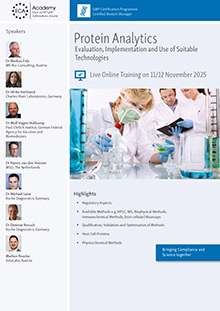ANALYSIS OF BIOPHARMACEUTICALS – AUTHORITY EXPECTATIONS
The term "biopharmaceuticals" comprises a very heterogeneous group of products which range, among others, from monoclonal antibodies, hormones, enzymes, plasma products and ATMPs to biosimilars. This results in several new challenges for manufacturers as well as for authorities to ensure the required safety and quality of the products in accordance with Directive 2001/83/EC.
This means that the manufacturer must have excellent knowledge and complete control of the manufacturing process, as the product is defined there. During the manufacturing process, impurities have to be eliminated without any negative impact on the product's biological activity. Of course, various materials, media and reagents of constant quality from qualified suppliers play a key role here. To ensure this quality, the therapeutic agent must be thoroughly tested and characterized during the early stages of product and process development. Appropriate test methods must be evaluated and implemented accordingly to allow for sustainable product characterization. These analytical methods are performed throughout the complete development process - in its early stage during clone screening, in vitro and in vivo testing for example, during the pre-clinical phase and, finally, during clinical studies by selected trial centres. The samples to be analysed may have different matrices, which makes it very complex and tricky.
Regarding the product life cycle, this would require process validation, inprocess control, release testing and, of course, the initial testing of reagents and excipients for the pre-marketing phase. In addition, for biosimilars, comparability with the reference product would have to be established in a stepwise approach (according to EMA/CHMP/437/04 Rev.1 and EMA/ CHMP/BWP/247713/2012).
During the post-marketing phase, changes of the manufacturing process/ the production site or the establishment of a new manufacturer may require further analysis and comparibility exercises.
Whereas inline, online or atline methods are commonly used with classical analysis, (matrix-specific) bioanalysis usually requires an offline methodology, since various methods, increase in time per method and specific measuring systems are frequently required. There, it is expected that the method used is sensitive, i.e. that it will detect the smallest structural differences or lowest amounts of impurities respectively that the smallest amount of an analyte can be quantified. Furthermore, high specification and robustness are expected to ensure the clear identification of the analyte.

Recommendation
Thursday, 26 February 2026 9 .30 - 15.30 h
Tissue – QC, Inspections and other Challenges - Live Online Training
The bioanalytical procedures used should also be validated according to ICH Q2(R1) as early as possible during development. Especially with highquality analyses, e.g. during proof of similarity of biosimilars or characterization of critical molecules, it may be reasonable and necessary to use orthogonal methods, i.e. to analyse a parameter with different methods. The increasing focus of European authorities on the 3R strategy (reduction, replacement, refinement) with regards to animal testing should be observed when selecting the test methods.
As a consequence, authority expectations can be summarized as follows:
- The relevant guidelines are to be observed, e.g. ICH Q2(R1), the Pharm. EU Product Monographies or, for biosimilars, "CHMP/437/04/ Rev.1 - Guideline on Similar Biological Medicinal Products".
- Validated methods should be used as early as possible during development - at the latest, during clinical phase III.
- Action mechanisms should be described in detail and clearly demonstrated, e.g. the binding capacity of specific receptors or antigens (possibly through different assays).
- If certain functional structures are not analysed, a scientific justification is required.
- In case of impurities, those reflecting activity or potency that influences the biological activity of the active ingredient and those with immunogenic properties should be determined (product-specific side effects).
- Furthermore, the reduction of contamination within the production process should be examined and limits should be determined according to the relevant industry guidelines if necessary.
- For raw and auxiliary materials, especially for those of biological origin, a content determination in the end product should be available and their possible influence on the active ingredient should be evaluated.
- Concerning the detection of socalled adventitious agents (e.g. mycoplasma or viruses), testing of the starting material and of the unprocessed bulk and/or evidence of the effective elimination of viral contaminants by the manufacturing process is expected. A potential contamination with prions must also be examined for some products.

Recommendation
Heidelberg, Germany3/4 March 2026
Virus Safety – Best Practices and Emerging Trends
Heterogeneous product groups such as biopharmaceuticals and biosimilars require the development of new test methods or the adjustment of existing ones. In that case, a corresponding justification of the chosen method, a short description, a list of differences to the previous method and relevant comparative data should be presented to the authorities. A good method transfer proving that other test laboratories/devices/etc. deliver comparable results is key here.
Authors:
Axel H. Schroeder
... is Operations Director and plans and conducts courses and conferences for the ECA in the area biotechnology and microbiology.
Dr Markus Fido
... is General Manager at Vela Labs in Vienna, Austria, and is in charge of the area Quality Operations and Regulatory Affairs.



